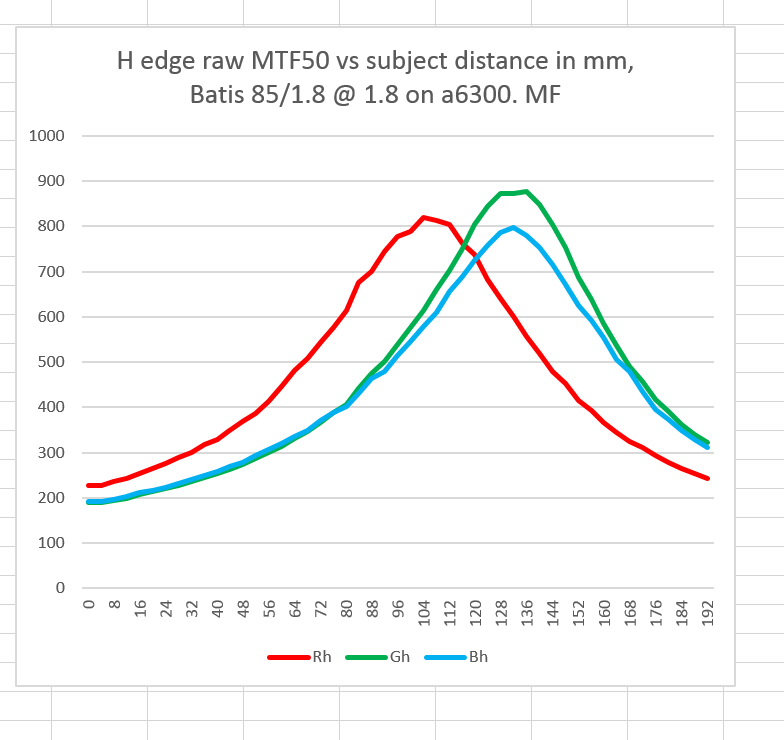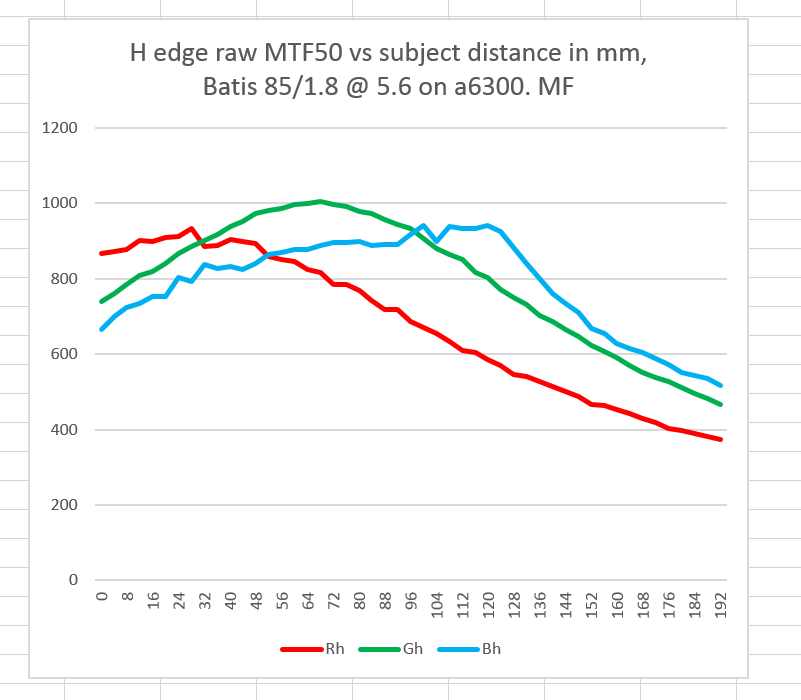This is part of a long series of posts about the Sony a6300. The series starts here.
In this test, I found that the Batis 85/1.8 lens had moderate focus shift and longitudinal chromatic aberration (LoCA). Then, when testing autofocus (AF) with that lens and the Sony a7RII, I found that the AF system did a good job of handling the focus shift, but tended to focus on the red raw plane rather than the green one, as we photographers would prefer.
I tested the a7RII AF system with other Sony FE mount lenses, and they focused as you’d expect. Was there a particular compatibility issue between the a7RII and the Batis 85, or would the Batis 85 perform similarly with another cameras. My curiosity about that, coupled with my desire to see how accurately the a6300 can autofocus, led me to repeat my testing with the same lens and the new camera.
I used this target, which has a focusing grid designed to be optimum for AF systems:

I am indebted to a DPR contributor with the screen name Horshack for the focusing target.
I lit the target with two Westcott LED panels, and set the color temperature to 5000K. I mounted a Sony a6300 with a Batis 85/1.8 on it to a Cognisys computer-driven focusing rail. I set the controller up to use 192mm of travel and make 49 exposures 4mm apart. I set the assembly 8 feet from the on-axis target, mounted the lens, focused mid-rail using manual focusing, and exposed at 49-shot series at f/1.8 and f/5.6. I also repeated the test with autofocus on, using Flexible Spot with small and medium spot sizes, and Expand Flexible Spot, with AD-S engaged, and the priority set to AF. I used Jack Hogan’s batch MTF program, DCRAW, and MTF Mapper to calculate the MTF50s for all the color planes, imported the data into Excel, and plotted the results in cycles per picture height vs distance from the point furthest away from the target.
He’s what happens if the camera is set wide open and doesn’t focus as it moves along the rail:
And here are the results at f/5.6:
The vertical axis is MTF50, measured in cycles per picture height. Higher is sharper. Farther away from the target is on the left, and the camera moves closer to the target as you move to the right on the graph.
- The fact that the three color planes show maximum sharpness at different distances to the target is evidence of LoCA.
- The shift of the location of sharpest focus towards the left as the lens is stopped down is evidence of focus shift.
- The slightly higher MTF50 values at the peak when the lens is stopped down to f/5.6 means that it is slightly sharper on-axis at f.5.6 than it is wide open.
- The broader curves stopped down are evidence of increased depth of field.
You can see that if the lens is focused wide open using the green plane, the red plane is quite a ways from the point of best focus. If the lens is focused wide open using the red plane, the green plane is almost as far from the point of best focus. That’s the quandary of LoCA.
When the lens is wide open and the camera is set to autofocus using flexible spot and a small spot size:
The AF system is pretty darned consistent in focusing on the wrong color plane, although you can see that once is screwed up and focused close to the right one. This AF consistency vastly exceeds what I am capable of using magnified manual focusing. It looks like this camera is as accurate as the a7RII, and that’s saying something.
With a medium spot size:
Even more consistent.
Using Expand Flexible Spot:
There’s one feint in the direction of the proper focus distance.
Stopped down to f/5.6, with flexible spot and small:
The AF system deals with the focus shift in an exemplary fashion. but still prefers the wrong color plane. There are a few more times when the green plane is favored.
With medium spot size:
I’d show you the Expand Flexible Spot curve for the f/5.6 case, but the camera could not reliably acquire focus under these conditions.
With the a7RII and the Batis 85/1.8, I found that there were some focusing targets that got the correct plane sharp. That’s probably true for the a6300.
My net:
- The a6300 AF system is remarkably accurate.
- The strange interaction between the Batis 85 and Sony E-mount cameras is not just a fluke.
- The a6300 AF system deals with focus shift very well.







One concerning aspect to your findings is that Zeiss E-mount lenses don’t have user upgradeable firmware. So any fix will mean sending the lens back to Zeiss for an upgrade.
I appreciate all your work with these tests. It would still be interesting to see the Batis AF test with an older A7 series camera to see if the CDAF or older hybrid-focus model exhibits the same issues.
Good work Jim, I wonder why that is. (Also what happened to the blue channel at f/5.6? It looks like it wanted to go on top of green, closer to the diffraction limits like it does in the a7RII).